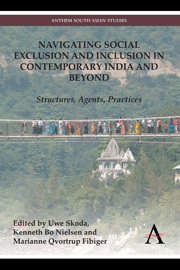 Navigating Social Exclusion and Inclusion in Contemporary India and Beyond
Navigating Social Exclusion and Inclusion in Contemporary India and Beyond from Part III - Resources and Development
Published online by Cambridge University Press: 05 September 2013
Mega-dam building in India in the post-independence era became a major symbol of modernization. Even today, the mega-dam continues to be seen as a symbol of progress, of man's supremacy over nature, of prosperity and of pride. However, due to construction of dams, many indigenous communities are displaced involuntarily and compensated marginally. It severely damages the rich sociocultural fabric of the marginalized people. In this process, the indigenous people suffer from economic and social marginalization in many important areas of community life. The rehabilitation and resettlement policies have often further marginalized the already marginalized people from life's opportunities. This has deprived this segment of the population from the rights and privileges enjoyed by the dominant sections of society. Countless studies and reports have documented that the interests of ‘development oustees’ were rarely taken into consideration when mega projects were built (Oliver-Smith 1991; Thukral 1992 and 1996; Parasuraman 1993 and 1999; Scudder 1996; Colson 1999; WCD 2000). Indigenous people seldom understand the long-term implications of development projects, and hence fail in their efforts to devise measures to counter them.
Recognizing this problem, World Bank sociologist Michael Cernea developed the highly influential Impoverishment Risks and Reconstruction (IRR) model (see Cernea 1994, 1997, 1998, 1999, 2000) now widely used in resettlement research (for example, Mathur and Marsden 1998). This model has been key in showing how displacement goes hand in hand with physical, social and economic exclusion.
To save this book to your Kindle, first ensure [email protected] is added to your Approved Personal Document E-mail List under your Personal Document Settings on the Manage Your Content and Devices page of your Amazon account. Then enter the ‘name’ part of your Kindle email address below. Find out more about saving to your Kindle.
Note you can select to save to either the @free.kindle.com or @kindle.com variations. ‘@free.kindle.com’ emails are free but can only be saved to your device when it is connected to wi-fi. ‘@kindle.com’ emails can be delivered even when you are not connected to wi-fi, but note that service fees apply.
Find out more about the Kindle Personal Document Service.
To save content items to your account, please confirm that you agree to abide by our usage policies. If this is the first time you use this feature, you will be asked to authorise Cambridge Core to connect with your account. Find out more about saving content to Dropbox.
To save content items to your account, please confirm that you agree to abide by our usage policies. If this is the first time you use this feature, you will be asked to authorise Cambridge Core to connect with your account. Find out more about saving content to Google Drive.